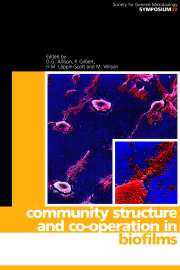Book contents
- Frontmatter
- Contents
- Contributors
- Editors' Preface
- An overview of biofilms as functional communities
- Initial microbial adhesion events: mechanisms and implications
- Physiological events in biofilm formation
- Environmental and genetic factors influencing biofilm structure
- Coaggregation and coadhesion in oral biofilms
- Cohesiveness in biofilm matrix polymers
- Microbial detachment from biofilms
- Modelling and predicting biofilm structure
- Microbial community interactions in biofilms
- Microbial communities: aggregates of individuals or co-ordinated systems
- Gene transfer in biofilms
- Population dynamics in microbial biofilms
- Biodegradation by biofilm communities
- Biofilms and prosthetic devices
- Biofilms: problems of control
- Biofilms in the New Millennium: musings from a peak in Xanadu
- Index
Environmental and genetic factors influencing biofilm structure
Published online by Cambridge University Press: 03 June 2010
- Frontmatter
- Contents
- Contributors
- Editors' Preface
- An overview of biofilms as functional communities
- Initial microbial adhesion events: mechanisms and implications
- Physiological events in biofilm formation
- Environmental and genetic factors influencing biofilm structure
- Coaggregation and coadhesion in oral biofilms
- Cohesiveness in biofilm matrix polymers
- Microbial detachment from biofilms
- Modelling and predicting biofilm structure
- Microbial community interactions in biofilms
- Microbial communities: aggregates of individuals or co-ordinated systems
- Gene transfer in biofilms
- Population dynamics in microbial biofilms
- Biodegradation by biofilm communities
- Biofilms and prosthetic devices
- Biofilms: problems of control
- Biofilms in the New Millennium: musings from a peak in Xanadu
- Index
Summary
INTRODUCTION
It is increasingly evident that biofilms growing in a diverse range of medical, industrial and natural environments form a similarly diverse range of complex structures (Stoodley et al., 1999a). These structures often contain water channels which can increase the supply of nutrients to cells in the biofilm (deBeer & Stoodley, 1995) and prompted Costerton et al. (1995) to propose that the water channels may serve as a rudimentary circulatory system of benefit to the biofilm as a whole. This concept suggests that biofilm structure may be controlled, to some extent, by the organisms themselves and may be optimized for a certain set of environmental conditions. To date, most of the research on biofilm structure has been focused on the influence of external environmental factors such as surface chemistry and roughness, physical forces (that is, hydrodynamic shear) or nutrient conditions and the chemistry of the aqueous environment. However, there has been a recent increase in the number of researchers using molecular techniques to study the genetic regulation of biofilm formation and development. Davies et al. (1998) demonstrated that the structure of a Pseudomonas aeruginosa biofilm could be controlled through production of the cell signal (or pheromone) N-(3-oxododecanoyl)-L-homoserine lactone (OdDHL). In this paper, we will examine some of the research that has been conducted in our laboratories and those of others on the relative contribution of hydrodynamics, nutrients and cell signalling to the structure and behaviour of bacterial biofilms.
HYDRODYNAMICS
The hydrodynamic conditions of an aquatic environment will determine the transport rate of nutrients and planktonic cells to a surface, the shear stress acting on the biofilm and the rate of erosion of cells from the biofilm.
- Type
- Chapter
- Information
- Community Structure and Co-operation in Biofilms , pp. 53 - 64Publisher: Cambridge University PressPrint publication year: 2000
- 4
- Cited by



